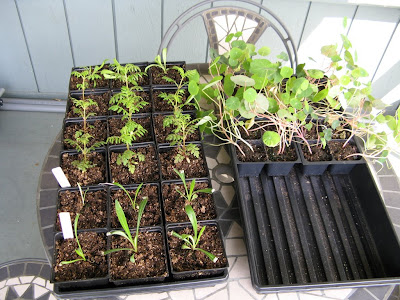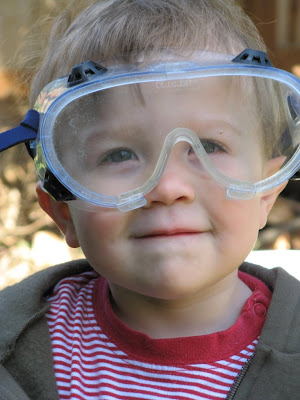I have to walk a delicate balance. I get bummed that I don't get more done on the yard, but I don't want to abandon the family to do it (besides, Cris gets grumpy if I don't help with the kids). So this past month I could either do stuff in the yard with my limited time, or I could blog about it. Your loss, I guess...
Progress has been made, though. Let me catch you up a bit. I managed to re-pot some seedlings into 3-inch pots. I really like the seedling trays and pots I bought from Charley's Greenhouse. The 10x20 inch trays hold 8 square seedling trays with 4, 6, or 9 seedlings per square. The seedling squares are interchangeable, so I don't have to commit to a full flat of the same-sized blocks. See this post for more details. 18 of the 3-inch square pots fit in the same 10x20 flat. Below you can see marigold, gazania, and felicia seedlings in the flat on the left and nasturtiums on the right. The nasturtiums got a bit leggy because I left them on the heating mat too long. I have two other kinds of nasturtiums anyway, so I gave them to Mary and planted phlox seeds ( Phlox drummondii 'Phlox of Sheep') in their stead.


Compare that to this image from last summer:
 There's the tree we planted last fall and the new beds on the eastern side of the yard. Looks a lot better now.
There's the tree we planted last fall and the new beds on the eastern side of the yard. Looks a lot better now.
In addition to the flat of seedlings, I've also planted a few bulbs that were probably out of date and a bunch of seeds. Most of these should have been planted a month ago, so I hope they work out.
There are more details, of course. I'm not doing a very good job of conveying certain information in a timely manner. This is a bummer, because a major purpose for this blog was to help me keep track of when certain things were happening in the garden (e.g. blooming) so I would know for next year.
Here's Lucas helping Dada with the chipper-shredder.
 There's the tree we planted last fall and the new beds on the eastern side of the yard. Looks a lot better now.
There's the tree we planted last fall and the new beds on the eastern side of the yard. Looks a lot better now.In addition to the flat of seedlings, I've also planted a few bulbs that were probably out of date and a bunch of seeds. Most of these should have been planted a month ago, so I hope they work out.
There are more details, of course. I'm not doing a very good job of conveying certain information in a timely manner. This is a bummer, because a major purpose for this blog was to help me keep track of when certain things were happening in the garden (e.g. blooming) so I would know for next year.
Here's Lucas helping Dada with the chipper-shredder.








